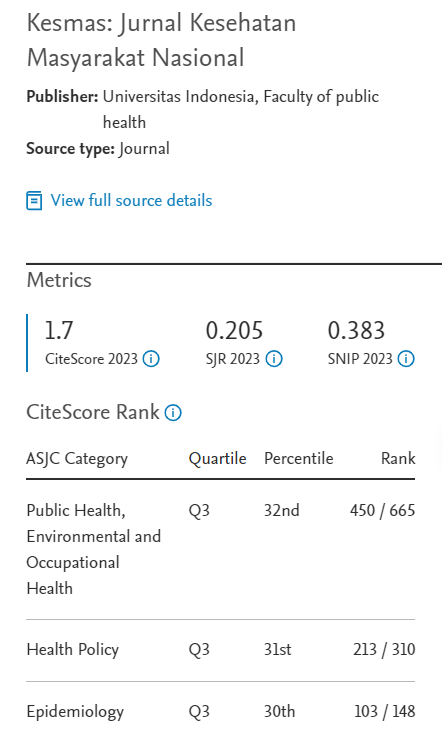Abstract
Sampai kini, demam berdarah dengue masih menjadi masalah kesehatan yang utama di Kota Depok. Hal tersebut terlihat pada jumlah kasus yang terus meningkat dan semua kelurahan sudah berkembang menjadi daerah endemis demam berdarah dengue yang dapat dicegah dengan mengendalikan vektor. Upaya pembersihan sarang nyamuk PSN 3M Plus adalah teknologi yang disarankan untuk mengendalikan kejadian demam berdarah dengue, tetapi belum mendapat dukungan pelaksanaan dari masyarakat. Studi ini bertujuan untuk menggali informasi tentang pengetahuan, sikap dan praktek masyarakat dalam pengendalian vektor demam berdarah dengue di Kota Depok. Hasil studi menunjukkan bahwa pengetahuan dan partisipasi masyarakat dalam pengendalian vektor DBD masih rendah, dan lingkungan sosial berpengaruh sangat dominan terhadap keputusan masyarakat.
Until now, dengue hemorrhaegic fever (DHF) is the major health problem in Depok City, number of cases was increasing, and nowadays all sub-district have DHF endemic areas. DHF can be prevented by vector control. PSN 3M Plus is the recommended technology, but the community has not been implemented it yet. This study aims to explore information about knowledge, attitude and practice in dengue control among the communities. Results of this study indicated that knowledge and community participation dengue vector control were still low, and social environment factor was the dominant factor influencing community decision.
References
- Pai HH, Hong YJ, Hsu EL. Impact of a short term community-based cleanliness campaign on the sources of dengue vectors: an entomological and human behavior study. Journal of Environmental Health: Academic Research Library. 2006; 68: 6.
- Kumar R, Krishnan SK, Rajashree N, Patil RR. Perceptions of mosquito borne diseases. Journal of Epidemiology and Community Health. 2003; 57, 5: 392.
- Leon RB. Promoting health: evidences for a fairer society. Promotion & Education. ProQuest Nursing & Allied Health Source. 2001: 24.
- Glanz K. Health behavior and health education: theory, research and practice. San Francisco: Josey-Bass Publishers; 1997.
- Kasnodihardjo dan Sumengen. Aspek perilaku dalam kaitannya dengan penyakit demam berdarah di Kodya Sukabumi. Jakarta: Badan Litbangkes Depkes RI; 1988.
- Green L, Kreuter MW, Deeds SG, Partridge KB. Health education today and the PRECEDE framework. Palo Alto, Calif.: Mayfield Publishing Co; 1979.
- Gomez FE, Suarez CMH, Cardenas RC. Educational campaign versus malathion spraying for the control of aedes aegypti in Colima, Mexico. Journal of Epidemiology and Community Health. 2002: 56, 2: 148.
- Therawiwat M, Fungladda W, Kaewkungwal J, Imamee N, Steckler A. Community-based approach for prevention and control of dengue hemorrhagic fever in Kanchanaburi Province, Thailand. Southeast Asian Jornal of Tropical Medicine and Public Health. 2005; 36, 6: 1439.
- Crabtree, Ashencaen S, Wong CM, Mas’ud F. Community participatory approaches to dengue prevention in Sarawak, Malaysia. Human Organization. 2001: 60, 3; 281.
- Yasumaro S, Silva ME, Andrighetti MTM, Macoris MDLG, Mazine CAB, et al. Community involvement in dengue prevention project in Marilia, Sao Paulo, Brazil. Human Organization. 1998: 57, 2; 209.
- Armstrong, Rebecca, Doyle J, Lamb C, Waters E. Multi-sectoral health promotion and public health: the role of evidence. Journal of Public Health [serial on the internet]. 2006; 28, 2: 168-172.
Recommended Citation
Krianto T .
Masyarakat Depok Memilih Fogging yang Tidak Dimengerti.
Kesmas.
2009;
4(1):
29-35
DOI: 10.21109/kesmas.v4i1.198
Available at:
https://scholarhub.ui.ac.id/kesmas/vol4/iss1/5







